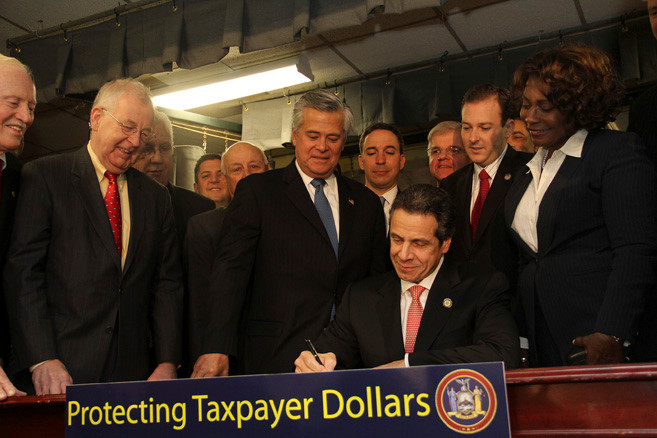MTA payroll tax reduction: How will it help, locally?
Gov. Andrew Cuomo signed legislation on Dec. 12 to reduce the Metropolitan Transportation Authority payroll tax —passed in 2009 to help the failing MTA and was effective in 12 counties served by the authority — relieving more than 290,000 small businesses and 410,000 entrepreneurs by $250 million, beginning April 1.
The reduction is part of a comprehensive plan to revitalize the state’s economy through job-creation for middle-class tax cuts. The Legislature passed the Middle Class Tax Cut and Job Creation bill on Dec. 7, assuring the MTA that it won’t be affected by legislation — any lost revenue will be made up by the state, according to the governor’s office.
The MTA payroll tax provided 14.3 percent of the MTA operating budget.
How will the MTA reduction help businesses?
Under the bill, the MTA tax on businesses with an annual payroll under $1.5 million will be reduced by 0.11 percent; for businesses with payroll less than $1.75 million, the tax will be reduced to 0.23 percent. Additionally, businesses that have a payroll of less than $1.25 million will get be given a permanent reprieve from the tax. According to Joseph Ardito, owner of local law firm Ardito & Ardito and president-elect of the Franklin Square Chamber of Commerce, the tax savings will be significant.
“Governor Cuomo has taken a long-needed step towards helping to spark some growth and momentum in our local economy by eliminating the burdensome MTA tax for what should amount to a large percentage of the small businesses in our area,” Ardito said, adding that he anticipates that the tax savings will help his firm hire new employees, upgrade equipment or fixtures, and bolster future projects or other business enhancements.
Pat Boyle, executive director of Gateway Youth Outreach, which runs an after-school program for elementary students in Elmont, said that although cost savings won’t be significant for GYO, “every penny counts.”
Boyle explained that tax only applies to full-time employees, and most of GYO’s employees are part-time workers and/or students. He added that the tax correlates with individual salaries, and since GYO’s few full-time employees, including Boyle, do not have large salaries, he said, the organizations savings from the reduction will be “miniscule.”
The reduction could be of more help in the future, however, if GYP were to expand. Despite only anticipating a small savings, “when the savings start coming through, they will be greatly appreciated” by GYO, Boyle added.
How will the MTA reduction help local schools?
In addition to local businesses, under the new law, both private and public schools will be exempt from the tax.
According to Maureen Kenny, assistant superintendent for finance and operations at the Sewanhaka High School Central District, the Sewanhaka district’s current budget for the MTA tax is $315,000. Normally, the district pays the tax and is later reimbursed by the state, she added.
Under the new law, school districts “break even,” she explained, since they will not have to include the tax in their 2012-13 budgets and they won’t receive a state reimbursement. “Although we will save $315,000 in expenses, our tax levy will not be affected because, since we were being reimbursed this money, we must also remove the same amount from our revenue budget,” she added.
Although the change doesn’t provide true savings to school districts, it allows them to work on budgets without accounting for an MTA tax, prevents them from having to wait on reimbursement, and prevents them from worrying about receiving a full and timely reimbursement from the state.
Is the reduction enough?
Pat Nicolosi, president of the Elmont East End Civic Association, said that although the reduction is a positive change, he doesn’t think it’s enough. “This tax is the worse possible tax and should have been eliminated entirely,” he said. “This tax is an example of taxation with out representation.”
He added that not only are businesses burdened by the tax, New Yorkers are affected when they pay businesses that increase prices to account for the tax, and through paying property taxes. “Property taxes had to go up because taxing districts had their budgets increased from the MTA tax,” he explained. “[The reduction] is going to help, but it’s not enough.”






